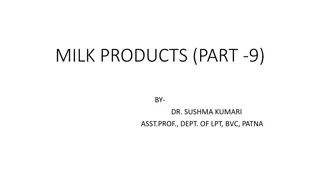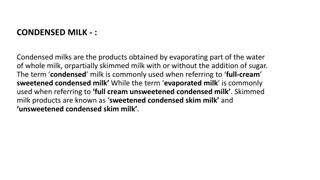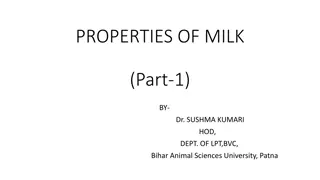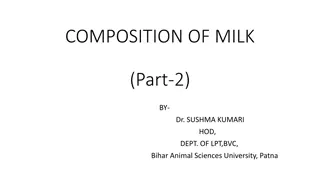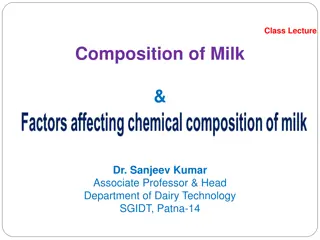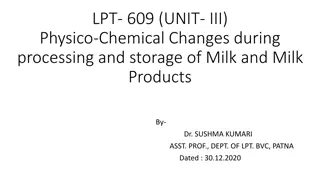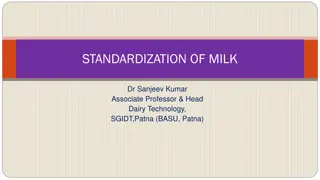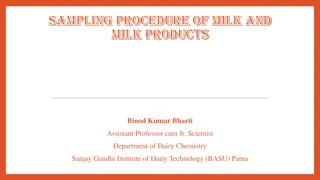Understanding Milk Freshness and Quality Control
Milk freshness is crucial for maintaining optimal nutrient composition and preventing excessive acidity due to microbial activity. Various tests and analyses are conducted to assess the freshness and appropriateness of milk for further processing, with titration methods being a common approach for measuring acidity levels. In Slovenia, the Soxhlet-Henkel titration method is the official method for determining milk acidity. Maintaining proper storage conditions and monitoring acidity levels are essential for ensuring milk quality.
Download Presentation

Please find below an Image/Link to download the presentation.
The content on the website is provided AS IS for your information and personal use only. It may not be sold, licensed, or shared on other websites without obtaining consent from the author. Download presentation by click this link. If you encounter any issues during the download, it is possible that the publisher has removed the file from their server.
E N D
Presentation Transcript
FRESHNESS OF MILK Name Surname
It is of utmost importance to know that milk has an optimal composition of nutrient substances; as such, it presents a suitable environment for many microorganisms. They already come into milk during milking on the way from the udder cistern through the teat canal, which is called initial or primary milk contamination. In raw milk of healthy animals, lactic acid bacteria prevail. In favourable circumstances they ferment lactose into lactic acid.
This microbiological activity leads to a higher level of milk acidity, which is the result of a long term or inappropriate milk storage. That is why the raw milk has to be cooled-down to 4 C right after milking. Such conditions must be maintained during the storage until the milk is transported to the dairy, which should be done as soon as possible. At this or lower temperature, the microorganisms' activities slow down, ensuring milk's freshness and longer durability.
The freshness of milk is indirectly measured by proving the amount of acidity, which is the result of: Natural acidity of fresh milk, provided by certain ingredients in milk: caseins, lots of salts of lower organic and inorganic acids (citrates, phosphates), ascorbic acid, free amino acids dissolved CO2. Subsequent acidity of milk, because of microbiological activities and decomposition of lactose into milk acid and other products of their metabolism. Important: Fresh milk does not contain lactic acid. This acid is the result of the present milk acid bacteria activities.
Freshness and appropriateness of milk for further production can be controlled in terms of quality and quantity. Quality analyses for measuring appropriateness of milk for further processing are: indicator sheets, alizarol tests, alcohol tests. Quantity analyses of milk acidity are titration methods and pH values measurements.
In Slovenia, the reference method, i.e. the officially recognised method for determining acidity, is the Soxhlet-Henkel titration method, in which a 0,25 M NaOH solution is used to neutralise 100 ml of milk and phenolphthalein is used as an indicator. 1 millilitre of NaOH consumed is 1 SH (read: Soxhlet-Henkel degrees). The titratable acidity of fresh milk usually ranges from 6.2 to 7.5 SH. These values range from 4 to 10 SH in some fresh milk samples, depending on the composition and buffering capacity of the milk.
In addition to the Soxhlet-Henkel method, some countries have: the Th rner method ( Th read: degrees Toerner), in which the titration is performed with a 0.1 M NaOH solution, the Dornic method ( D read: Dornic degrees), using a 0,11 M NaOH solution. The relationship between the individual titration values/methods is: 1 SH = 2.5 Th = 2.25 D Active acidity of fresh milk and pH-value of milk are measured by pH- measurement instrument and vary between pH value 6.5 - 6.7. The limit pH-values are between 6.3 - 6.9.


